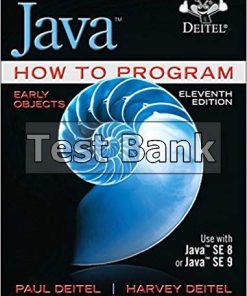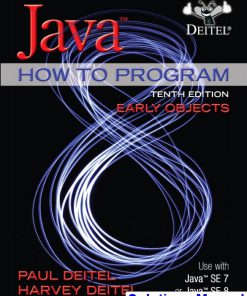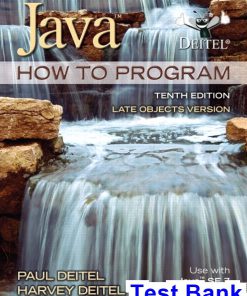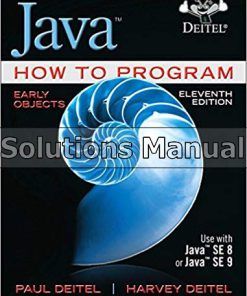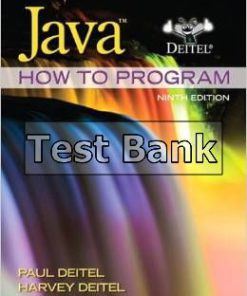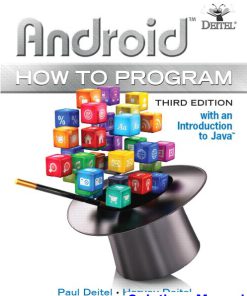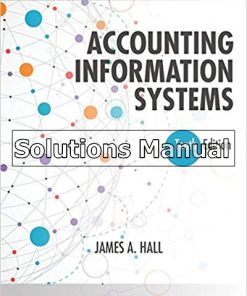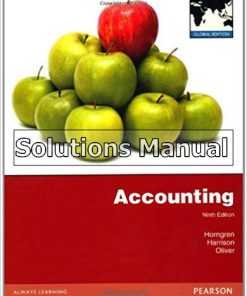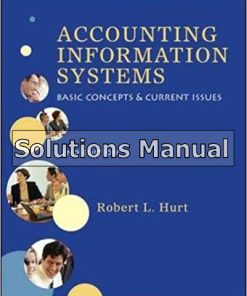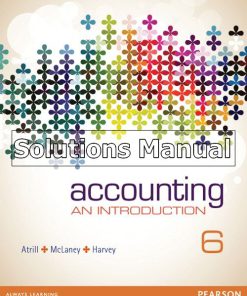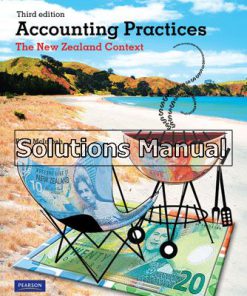Java How to Program 9th Edition Deitel Solutions Manual
You may also like
-
$26.50
$50.00
Java How to Program 9th Edition Deitel Solutions Manual

Product details:
- ISBN-10 : 9780132575669
- ISBN-13 : 978-0132575669
- Author: Paul J. Deitel
The Deitels groundbreaking How to Program series offers unparalleled breadth and depth of object-oriented programming concepts and intermediate-level topics for further study. Their Live Code Approach features thousands of lines of code in hundreds of complete working programs. This enables readers to confirm that programs run as expected.Java How to Program (Early Objects) 9econtains an optional extensive OOD/UML 2 case study on developing and implementing the software for an automated teller machine.This edition covers both Java SE7 and SE6.
Table contents:
Preface xxiii Before You Begin xxxiii 1 Introduction to Computers and Java 1 1.1 Introduction 2 1.2 Computers: Hardware and Software 5 1.3 Data Hierarchy 6 1.4 Computer Organization 8 1.5 Machine Languages, Assembly Languages and High-Level Languages 10 1.6 Introduction to Object Technology 11 1.7 Operating Systems 13 1.8 Programming Languages 16 1.9 Java and a Typical Java Development Environment 18 1.10 Test-Driving a Java Application 22 1.11 Web 2.0: Going Social 26 1.12 Software Technologies 29 1.13 Keeping Up-to-Date with Information Technologies 31 1.14 Wrap-Up 32
2 Introduction to Java Applications 37 2.1 Introduction 38 2.2 Your First Program in Java: Printing a Line of Text 38 2.3 Modifying Your First Java Program 44 2.4 Displaying Text with printf 46 2.5 Another Application: Adding Integers 47 2.6 Memory Concepts 52 2.7 Arithmetic 53 2.8 Decision Making: Equality and Relational Operators 56 2.9 Wrap-Up 60
3 Introduction to Classes, Objects, Methods and Strings 71 3.1 Introduction 72 3.2 Declaring a Class with a Method and Instantiating an Object of a Class 72 3.3 Declaring a Method with a Parameter 76 3.4 Instance Variables, set Methods and get Methods 79 3.5 Primitive Types vs. Reference Types 84 3.6 Initializing Objects with Constructors 85 3.7 Floating-Point Numbers and Type double 88 3.8 (Optional) GUI and Graphics Case Study: Using Dialog Boxes 92 3.9 Wrap-Up 95
4 Control Statements: Part 1 102 4.1 Introduction 103 4.2 Algorithms 103 4.3 Pseudocode 104 4.4 Control Structures 104 4.5 if Single-Selection Statement 107 4.6 if…else Double-Selection Statement 107 4.7 while Repetition Statement 112 4.8 Formulating Algorithms: Counter-Controlled Repetition 113 4.9 Formulating Algorithms: Sentinel-Controlled Repetition 118 4.10 Formulating Algorithms: Nested Control Statements 125 4.11 Compound Assignment Operators 130 4.12 Increment and Decrement Operators 130 4.13 Primitive Types 134 4.14 (Optional) GUI and Graphics Case Study: Creating Simple Drawings 134 4.15 Wrap-Up 138
5 Control Statements: Part 2 151 5.1 Introduction 152 5.2 Essentials of Counter-Controlled Repetition 152 5.3 for Repetition Statement 154 5.4 Examples Using the for Statement 158 5.5 do…while Repetition Statement 162 5.6 switch Multiple-Selection Statement 164 5.7 break and continue Statements 172 5.8 Logical Operators 173 5.9 Structured Programming Summary 179 5.10 (Optional) GUI and Graphics Case Study: Drawing Rectangles and Ovals 184 5.11 Wrap-Up 187
6 Methods: A Deeper Look 197 6.1 Introduction 198 6.2 Program Modules in Java 198 6.3 static Methods, static Fields and Class Math 200 6.4 Declaring Methods with Multiple Parameters 202 6.5 Notes on Declaring and Using Methods 205 6.6 Method-Call Stack and Activation Records 206 6.7 Argument Promotion and Casting 207 6.8 Java API Packages 208 6.9 Case Study: Random-Number Generation 210 6.9.1 Generalized Scaling and Shifting of Random Numbers 214 6.9.2 Random-Number Repeatability for Testing and Debugging 214 6.10 Case Study: A Game of Chance; Introducing Enumerations 215 6.11 Scope of Declarations 219 6.12 Method Overloading 222 6.13 (Optional) GUI and Graphics Case Study: Colors and Filled Shapes 224 6.14 Wrap-Up 227
7 Arrays and ArrayLists 240 7.1 Introduction 241 7.2 Arrays 242 7.3 Declaring and Creating Arrays 243 7.4 Examples Using Arrays 244 7.5 Case Study: Card Shuffling and Dealing Simulation 254 7.6 Enhanced for Statement 258 7.7 Passing Arrays to Methods 259 7.8 Case Study: Class GradeBook Using an Array to Store Grades 262 7.9 Multidimensional Arrays 268 7.10 Case Study: Class GradeBook Using a Two-Dimensional Array 271 7.11 Variable-Length Argument Lists 278 7.12 Using Command-Line Arguments 279 7.13 Class Arrays 281 7.14 Introduction to Collections and Class ArrayList 284 7.15 (Optional) GUI and Graphics Case Study: Drawing Arcs 286 7.16 Wrap-Up 289
8 Classes and Objects: A Deeper Look 311 8.1 Introduction 312 8.2 Time Class Case Study 312 8.3 Controlling Access to Members 316 8.4 Referring to the Current Object’s Members with the this Reference 317 8.5 Time Class Case Study: Overloaded Constructors 320 8.6 Default and No-Argument Constructors 326 8.7 Notes on Set and Get Methods 326 8.8 Composition 328 8.9 Enumerations 331 8.10 Garbage Collection and Method finalize 333 8.11 static Class Members 334 8.12 static Import 338 8.13 final Instance Variables 339 8.14 Time Class Case Study: Creating Packages 340 8.15 Package Access 345 8.16 (Optional) GUI and Graphics Case Study: Using Objects with Graphics 347 8.17 Wrap-Up 351
9 Object-Oriented Programming: Inheritance 359 9.1 Introduction 360 9.2 Superclasses and Subclasses 361 9.3 protected Members 363 9.4 Relationship between Superclasses and Subclasses 364 9.4.1 Creating and Using a CommissionEmployee Class 364 9.4.2 Creating and Using a BasePlusCommissionEmployee Class 370 9.4.3 Creating a CommissionEmployee—BasePlusCommissionEmployee Inheritance Hierarchy 375 9.4.4 CommissionEmployee—BasePlusCommissionEmployee Inheritance Hierarchy Using protected Instance Variables 377 9.4.5 CommissionEmployee—BasePlusCommissionEmployee Inheritance Hierarchy Using private Instance Variables 380 9.5 Constructors in Subclasses 385 9.6 Software Engineering with Inheritance 386 9.7 Class Object 387 9.8 (Optional) GUI and Graphics Case Study: Displaying Text and Images Using Labels 388 9.9 Wrap-Up 391
10 Object-Oriented Programming: Polymorphism 394 10.1 Introduction 395 10.2 Polymorphism Examples 397 10.3 Demonstrating Polymorphic Behavior 398 10.4 Abstract Classes and Methods 400 10.5 Case Study: Payroll System Using Polymorphism 403 10.5.1 Abstract Superclass Employee 404 10.5.2 Concrete Subclass SalariedEmployee 407 10.5.3 Concrete Subclass HourlyEmployee 408 10.5.4 Concrete Subclass CommissionEmployee 410 10.5.5 Indirect Concrete Subclass BasePlusCommissionEmployee 412 10.5.6 Polymorphic Processing, Operator instanceof and Downcasting 413 10.5.7 Summary of the Allowed Assignments Between Superclass and Subclass Variables 418 10.6 final Methods and Classes 418 10.7 Case Study: Creating and Using Interfaces 419 10.7.1 Developing a Payable Hierarchy 421 10.7.2 Interface Payable 422 10.7.3 Class Invoice 422 10.7.4 Modifying Class Employee to Implement Interface Payable 425 10.7.5 Modifying Class SalariedEmployee for Use in the Payable Hierarchy 427 10.7.6 Using Interface Payable to Process Invoices and Employees Polymorphically 428 10.7.7 Common Interfaces of the Java API 430 10.8 (Optional) GUI and Graphics Case Study: Drawing with Polymorphism 431 10.9 Wrap-Up 433
11 Exception Handling: A Deeper Look 438 11.1 Introduction 439 11.2 Example: Divide by Zero without Exception Handling 439 11.3 Example: Handling ArithmeticExceptions and InputMismatchExceptions 442 11.4 When to Use Exception Handling 447 11.5 Java Exception Hierarchy 447 11.6 finally Block 450 11.7 Stack Unwinding and Obtaining Information from an Exception Object 454 11.8 Chained Exceptions 457 11.9 Declaring New Exception Types 459 11.10 Preconditions and Postconditions 460 11.11 Assertions 461 11.12 (New in Java SE 7) Multi-catch: Handling Multiple Exceptions in One catch 462 11.13 (New in Java SE 7) try-with-Resources: Automatic Resource Deallocation 463 11.14 Wrap-Up 463
12 ATM Case Study, Part 1: Object-Oriented Design with the UML 469 12.1 Case Study Introduction 470 12.2 Examining the Requirements Document 470 12.3 Identifying the Classes in a Requirements Document 478 12.4 Identifying Class Attributes 484 12.5 Identifying Objects’ States and Activities 489 12.6 Identifying Class Operations 493 12.7 Indicating Collaboration Among Objects 499 12.8 Wrap-Up 506
13 ATM Case Study Part 2: Implementing an Object-Oriented Design 510 13.1 Introduction 511 13.2 Starting to Program the Classes of the ATM System 511 13.3 Incorporating Inheritance and Polymorphism into the ATM System 516 13.4 ATM Case Study Implementation 522 13.4.1 Class ATM 523 13.4.2 Class Screen 528 13.4.3 Class Keypad 529 13.4.4 Class CashDispenser 530 13.4.5 Class DepositSlot 531 13.4.6 Class Account 532 13.4.7 Class BankDatabase 534 13.4.8 Class Transaction 537 13.4.9 Class BalanceInquiry 538 13.4.10 Class Withdrawal 539 13.4.11 Class Deposit 543 13.4.12 Class ATMCaseStudy 546 13.5 Wrap-Up 546
14 GUI Components: Part 1 549 14.1 Introduction 550 14.2 Java’s New Nimbus Look-and-Feel 551 14.3 Simple GUI-Based Input/Output with JOptionPane 552 14.4 Overview of Swing Components 555 14.5 Displaying Text and Images in a Window 557 14.6 Text Fields and an Introduction to Event Handling with Nested Classes 561 14.7 Common GUI Event Types and Listener Interfaces 567 14.8 How Event Handling Works 569 14.9 JButton 571 14.10 Buttons That Maintain State 574 14.10.1 JCheckBox 574 14.10.2 JRadioButton 577 14.11 JComboBox; Using an Anonymous Inner Class for Event Handling 580 14.12 JList 584 14.13 Multiple-Selection Lists 586 14.14 Mouse Event Handling 589 14.15 Adapter Classes 594 14.16 JPanel Subclass for Drawing with the Mouse 597 14.17 Key Event Handling 601 14.18 Introduction to Layout Managers 604 14.18.1 FlowLayout 605 14.18.2 BorderLayout 608 14.18.3 GridLayout 611 14.19 Using Panels to Manage More Complex Layouts 613 14.20 JTextArea 615 14.21 Wrap-Up 618
15 Graphics and Java 2D 631 15.1 Introduction 632 15.2 Graphics Contexts and Graphics Objects 634 15.3 Color Control 635 15.4 Manipulating Fonts 642 15.5 Drawing Lines, Rectangles and Ovals 647 15.6 Drawing Arcs 651 15.7 Drawing Polygons and Polylines 654 15.8 Java 2D API 657 15.9 Wrap-Up 664
16 Strings, Characters and Regular Expressions 672 16.1 Introduction 673 16.2 Fundamentals of Characters and Strings 673 16.3 Class String 674 16.3.1 String Constructors 674 16.3.2 String Methods length, charAt and getChars 675 16.3.3 Comparing Strings 676 16.3.4 Locating Characters and Substrings in Strings 681 16.3.5 Extracting Substrings from Strings 683 16.3.6 Concatenating Strings 684 16.3.7 Miscellaneous String Methods 684 16.3.8 String Method valueOf 686 16.4 Class StringBuilder 687 16.4.1 StringBuilder Constructors 688 16.4.2 StringBuilder Methods length, capacity, setLength and ensureCapacity 688 16.4.3 StringBuilder Methods charAt, setCharAt, getChars and reverse 690 16.4.4 StringBuilder append Methods 691 16.4.5 StringBuilder Insertion and Deletion Methods 693 16.5 Class Character 694 16.6 Tokenizing Strings 699 16.7 Regular Expressions, Class Pattern and Class Matcher 700 16.8 Wrap-Up 708
17 Files, Streams and Object Serialization 719 17.1 Introduction 720 17.2 Files and Streams 720 17.3 Class File 722 17.4 Sequential-Access Text Files 726 17.4.1 Creating a Sequential-Access Text File 726 17.4.2 Reading Data from a Sequential-Access Text File 733 17.4.3 Case Study: A Credit-Inquiry Program 736 17.4.4 Updating Sequential-Access Files 741 17.5 Object Serialization 742 17.5.1 Creating a Sequential-Access File Using Object Serialization 743 17.5.2 Reading and Deserializing Data from a Sequential-Access File 749 17.6 Additional java.io Classes 751 17.6.1 Interfaces and Classes for Byte-Based Input and Output 751 17.6.2 Interfaces and Classes for Character-Based Input and Output 753 17.7 Opening Files with JFileChooser 754 17.8 Wrap-Up 757
18 Recursion 765 18.1 Introduction 766 18.2 Recursion Concepts 767 18.3 Example Using Recursion: Factorials 768 18.4 Example Using Recursion: Fibonacci Series 771 18.5 Recursion and the Method-Call Stack 774 18.6 Recursion vs. Iteration 776 18.7 Towers of Hanoi 777 18.8 Fractals 779 18.9 Recursive Backtracking 790 18.10 Wrap-Up 790
19 Searching, Sorting and Big O 798 19.1 Introduction 799 19.2 Searching Algorithms 800 19.2.1 Linear Search 800 19.2.2 Binary Search 804 19.3 Sorting Algorithms 809 19.3.1 Selection Sort 810 19.3.2 Insertion Sort 814 19.3.3 Merge Sort 817 19.4 Wrap-Up 824
20 Generic Collections 829 20.1 Introduction 830 20.2 Collections Overview 830 20.3 Type-Wrapper Classes for Primitive Types 831 20.4 Autoboxing and Auto-Unboxing 832 20.5 Interface Collection and Class Collections 832 20.6 Lists 833 20.6.1 ArrayList and Iterator 834 20.6.2 LinkedList 836 20.7 Collections Methods 841 20.7.1 Method sort 842 20.7.2 Method shuffle 845 20.7.3 Methods reverse, fill, copy, max and min 847 20.7.4 Method binarySearch 849 20.7.5 Methods addAll, frequency and disjoint 851 20.8 Stack Class of Package java.util 853 20.9 Class PriorityQueue and Interface Queue 855 20.10 Sets 856 20.11 Maps 859 20.12 Properties Class 863 20.13 Synchronized Collections 866 20.14 Unmodifiable Collections 866 20.15 Abstract Implementations 867 20.16 Wrap-Up 867
21 Generic Classes and Methods 873 21.1 Introduction 874 21.2 Motivation for Generic Methods 874 21.3 Generic Methods: Implementation and Compile-Time Translation 877 21.4 Additional Compile-Time Translation Issues: Methods That Use a Type Parameter as the Return Type 880 21.5 Overloading Generic Methods 883 21.6 Generic Classes 883 21.7 Raw Types 891 21.8 Wildcards in Methods That Accept Type Parameters 895 21.9 Generics and Inheritance: Notes 899 21.10 Wrap-Up 900
22 Custom Generic Data Structures 904 22.1 Introduction 905 22.2 Self-Referential Classes 905 22.3 Dynamic Memory Allocation 906 22.4 Linked Lists 907 22.5 Stacks 917 22.6 Queues 921 22.7 Trees 924 22.8 Wrap-Up 930
23 Applets and Java Web Start 941 23.1 Introduction 942 23.2 Sample Applets Provided with the JDK 943 23.3 Simple Java Applet: Drawing a String 947 23.3.1 Executing WelcomeApplet in the appletviewer 949 23.3.2 Executing an Applet in a Web Browser 951 23.4 Applet Life-Cycle Methods 951 23.5 Initialization with Method init 952 23.6 Sandbox Security Model 954 23.7 Java Web Start and the Java Network Launch Protocol (JNLP) 956 23.7.1 Packaging the DrawTest Applet for Use with Java Web Start 956 23.7.2 JNLP Document for the DrawTest Applet 957 23.8 Wrap-Up 961
24 Multimedia: Applets and Applications 967 24.1 Introduction 968 24.2 Loading, Displaying and Scaling Images 969 24.3 Animating a Series of Images 975 24.4 Image Maps 982 24.5 Loading and Playing Audio Clips 985 24.6 Playing Video and Other Media with Java Media Framework 988 24.7 Wrap-Up 992 24.8 Web Resources 992
25 GUI Components: Part 2 1000 25.1 Introduction 1001 25.2 JSlider 1001 25.3 Windows: Additional Notes 1005 25.4 Using Menus with Frames 1006 25.5 JPopupMenu 1014 25.6 Pluggable Look-and-Feel 1017 25.7 JDesktopPane and JInternalFrame 1022 25.8 JTabbedPane 1026 25.9 Layout Managers: BoxLayout and GridBagLayout 1028 25.10 Wrap-Up 1040
26 Multithreading 1045 26.1 Introduction 1046 26.2 Thread States: Life Cycle of a Thread 1048 26.3 Creating and Executing Threads with Executor Framework 1051 26.4 Thread Synchronization 1054 26.4.1 Unsynchronized Data Sharing 1055 26.4.2 Synchronized Data Sharing–Making Operations Atomic 1059 26.5 Producer/Consumer Relationship without Synchronization 1062 26.6 Producer/Consumer Relationship: ArrayBlockingQueue 1070 26.7 Producer/Consumer Relationship with Synchronization 1073 26.8 Producer/Consumer Relationship: Bounded Buffers 1079 26.9 Producer/Consumer Relationship: The Lock and Condition Interfaces 1086 26.10 Concurrent Collections Overview 1093 26.11 Multithreading with GUI 1095 26.11.1 Performing Computations in a Worker Thread 1096 26.11.2 Processing Intermediate Results with SwingWorker 1102 26.12 Interfaces Callable and Future 1109 26.13 Java SE 7: Fork/Join Framework 1109 26.14 Wrap-Up 1110
27 Networking 1118 27.1 Introduction 1119 27.2 Manipulating URLs 1120 27.3 Reading a File on a Web Server 1125 27.4 Establishing a Simple Server Using Stream Sockets 1128 27.5 Establishing a Simple Client Using Stream Sockets 1130 27.6 Client/Server Interaction with Stream Socket Connections 1130 27.7 Datagrams: Connectionless Client/Server Interaction 1142 27.8 Client/Server Tic-Tac-Toe Using a Multithreaded Server 1150 27.9 [Web Bonus] Case Study: DeitelMessenger 1165 27.10 Wrap-Up 1165
28 Accessing Databases with JDBC 1171 28.1 Introduction 1172 28.2 Relational Databases 1173 28.3 Relational Database Overview: The books Database 1174 28.4 SQL 1177 28.4.1 Basic SELECT Query 1178 28.4.2 WHERE Clause 1179 28.4.3 ORDER BY Clause 1181 28.4.4 Merging Data from Multiple Tables: INNER JOIN 1182 28.4.5 INSERT Statement 1184 28.4.6 UPDATE Statement 1185 28.4.7 DELETE Statement 1186 28.5 Instructions for Installing MySQL and MySQL Connector/J 1186 28.6 Instructions for Setting Up a MySQL User Account 1187 28.7 Creating Database books in MySQL 1188 28.8 Manipulating Databases with JDBC 1189 28.8.1 Connecting to and Querying a Database 1189 28.8.2 Querying the books Database 1194 28.9 RowSet Interface 1207 28.10 Java DB/Apache Derby 1209 28.11 PreparedStatements 1211 28.12 Stored Procedures 1226 28.13 Transaction Processing 1227 28.14 Wrap-Up 1227 28.15 Web Resources 1228 29 JavaServer™ Faces Web Apps: Part 1 1235 29.1 Introduction 1236 29.2 HyperText Transfer Protocol (HTTP) Transactions 1237 29.3 Multitier Application Architecture 1240 29.4 Your First JSF Web App 1241 29.4.1 The Default index.xhtml Document: Introducing Facelets 1242 29.4.2 Examining the WebTimeBean Class 1244 29.4.3 Building the WebTime JSF Web App in NetBeans 1246 29.5 Model-View-Controller Architecture of JSF Apps 1250 29.6 Common JSF Components 1250 29.7 Validation Using JSF Standard Validators 1254 29.8 Session Tracking 1261 29.8.1 Cookies 1262 29.8.2 Session Tracking with @SessionScoped Beans 1263 29.9 Wrap-Up 1269
30 JavaServer™ Faces Web Apps: Part 2 1276 30.1 Introduction 1277 30.2 Accessing Databases in Web Apps 1277 30.2.1 Setting Up the Database 1279 30.2.2 @ManagedBean Class AddressBean 1282 30.2.3 index.xhtml Facelets Page 1286 30.2.4 addentry.xhtml Facelets Page 1288 30.3 Ajax 1290 30.4 Adding Ajax Functionality to the Validation App 1292 30.5 Wrap-Up 1295
31 Web Services 1299 31.1 Introduction 1300 31.2 Web Service Basics 1302 31.3 Simple Object Access Protocol (SOAP) 1302 31.4 Representational State Transfer (REST) 1302 31.5 JavaScript Object Notation (JSON) 1303 31.6 Publishing and Consuming SOAP-Based Web Services 1303 31.6.1 Creating a Web Application Project and Adding a Web Service Class in NetBeans 1303 31.6.2 Defining the WelcomeSOAP Web Service in NetBeans 1304 31.6.3 Publishing the WelcomeSOAP Web Service from NetBeans 1307 31.6.4 Testing the WelcomeSOAP Web Service with GlassFish Application Server’s Tester Web Page 1308 31.6.5 Describing a Web Service with the Web Service Description Language (WSDL) 1309 31.6.6 Creating a Client to Consume the WelcomeSOAP Web Service 1310 31.6.7 Consuming the WelcomeSOAP Web Service 1312 31.7 Publishing and Consuming REST-Based XML Web Services 1315 31.7.1 Creating a REST-Based XML Web Service 1315 31.7.2 Consuming a REST-Based XML Web Service 1318 31.8 Publishing and Consuming REST-Based JSON Web Services 1320 31.8.1 Creating a REST-Based JSON Web Service 1320 31.8.2 Consuming a REST-Based JSON Web Service 1322 31.9 Session Tracking in a SOAP Web Service 1324 31.9.1 Creating a Blackjack Web Service 1325 31.9.2 Consuming the Blackjack Web Service 1328 31.10 Consuming a Database-Driven SOAP Web Service 1339 31.10.1 Creating the Reservation Database 1340 31.10.2 Creating a Web Application to Interact with the Reservation Service 1343 31.11 Equation Generator: Returning User-Defined Types 1346 31.11.1 Creating the EquationGeneratorXML Web Service 1349 31.11.2 Consuming the EquationGeneratorXML Web Service 1350 31.11.3 Creating the EquationGeneratorJSON Web Service 1354 31.11.4 Consuming the EquationGeneratorJSON Web Service 1354 31.12 Wrap-Up 1357
A Operator Precedence Chart 1365 B ASCII Character Set 1367 C Keywords and Reserved Words 1368 D Primitive Types 1369 E Using the Java API Documentation 1370 E.1 Introduction 1370 E.2 Navigating the Java API 1370 F Using the Debugger 1378 F.1 Introduction 1379 F.2 Breakpoints and the run, stop, cont and print Commands 1379 F.3 The print and set Commands 1383 F.4 Controlling Execution Using the step, step up and next Commands 1385 F.5 The watch Command 1388 F.6 The clear Command 1391 F.7 Wrap-Up 1393 G Formatted Output 1395 G.1 Introduction 1396 G.2 Streams 1396 G.3 Formatting Output with printf 1396 G.4 Printing Integers 1397 G.5 Printing Floating-Point Numbers 1398 G.6 Printing Strings and Characters 1400 G.7 Printing Dates and Times 1401 G.8 Other Conversion Characters 1403 G.9 Printing with Field Widths and Precisions 1405 G.10 Using Flags in the printf Format String 1407 G.11 Printing with Argument Indices 1411 G.12 Printing Literals and Escape Sequences 1411 G.13 Formatting Output with Class Formatter 1412 G.14 Wrap-Up 1413 H Number Systems 1418 H.1 Introduction 1419 H.2 Abbreviating Binary Numbers as Octal and Hexadecimal Numbers 1422 H.3 Converting Octal and Hexadecimal Numbers to Binary Numbers 1423 H.4 Converting from Binary, Octal or Hexadecimal to Decimal 1423 H.5 Converting from Decimal to Binary, Octal or Hexadecimal 1424 H.6 Negative Binary Numbers: Two’s Complement Notation 1426 I GroupLayout 1431 I.1 Introduction 1431 I.2 GroupLayout Basics 1431 I.3 Building a ColorChooser 1432 I.4 GroupLayout Web Resources 1442 J Java Desktop Integration Components 1443 J.1 Introduction 1443 J.2 Splash Screens 1443 J.3 Desktop Class 1445 J.4 Tray Icons 1447 K Mashups 1449 K.1 Introduction 1449 K.2 Popular Mashups 1449 K.3 APIs Commonly Used in Mashups 1450 K.4 Deitel Mashups Resource Center 1450 K.5 Deitel RSS Resource Center 1451 K.6 Mashup Performance and Reliability Issues 1451 L Unicode® 1452 L.1 Introduction 1452 L.2 Unicode Transformation Formats 1453 L.3 Characters and Glyphs 1454 L.4 Advantages/Disadvantages of Unicode 1454 L.5 Using Unicode 1455 L.6 Character Ranges 1457 Appendices on the Web 1459 Index 1461
Appendices M—Q are PDF documents posted online at the book’s Companion Website (www.pearsonhighered.com/deitel/). M Creating Documentation with javadoc M-1 M.1 Introduction M-1 M.2 Documentation Comments M-1 M.3 Documenting Java Source Code M-1 M.4 javadoc M-8 M.5 Files Produced by javadoc M-9 N Bit Manipulation N-1 N.1 Introduction N-1 N.2 Bit Manipulation and the Bitwise Operators N-1 N.3 BitSet Class N-11 O Labeled break and continue Statements O-1 O.1 Introduction O-1 O.2 Labeled break Statement O-1 O.3 Labeled continue Statement O-2 P UML 2: Additional Diagram Types P-1 P.1 Introduction P-1 P.2 Additional Diagram Types P-1 Q Design Patterns Q-1 Q.1 Introduction Q-1 Q.2 Creational, Structural and Behavioral Design Patterns Q-2 Q.2.1 Creational Design Patterns Q-3 Q.2.2 Structural Design Patterns Q-5 Q.2.3 Behavioral Design Patterns Q-6 Q.2.4 Conclusion Q-7 Q.3 Design Patterns in Packages java.awt and javax.swing Q-7 Q.3.1 Creational Design Patterns Q-7 Q.3.2 Structural Design Patterns Q-8 Q.3.3 Behavioral Design Patterns Q-10 Q.3.4 Conclusion Q-13 Q.4 Concurrency Design Patterns Q-14 Q.5 Design Patterns Used in Packages java.io and java.net Q-15 Q.5.1 Creational Design Patterns Q-15 Q.5.2 Structural Design Patterns Q-15 Q.5.3 Architectural Patterns Q-16 Q.5.4 Conclusion Q-19 Q.6 Design Patterns Used in Package java.util Q-19 Q.6.1 Creational Design Patterns Q-19 Q.6.2 Behavioral Design Patterns Q-19 Q.7 Wrap-Up Q-20
People also search:
java how to program 9th edition
java how to program 9th edition solutions github
java how to program 9th edition ppt
java how to program 9th edition solution
|
java how to program 9th edition exercise solutions
|
a guide to programming in java answer key

